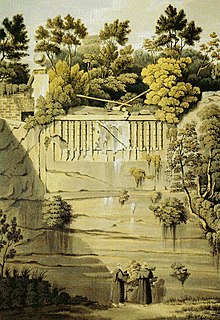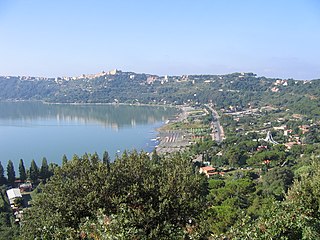
Castel Gandolfo, colloquially known as Castello in the Castelli Romani dialects, is a town located 25 km (16 mi) southeast of Rome, in the Italian region of Lazio. Situated on a hilltop in the Alban Hills with panoramic views of Lake Albano, Castel Gandolfo is home to approximately 8,900 residents and is renowned as one of Italy's most scenic towns. It is one of I Borghi più belli d'Italia.

Santa Maria sopra Minerva is one of the major churches of the Order of Preachers in Rome, Italy. The church's name derives from the fact that the first Christian church structure on the site was built directly over the ruins or foundations of a temple dedicated to the Egyptian goddess Isis, which had been erroneously ascribed to the Greco-Roman goddess Minerva.

Albano Laziale is a comune (municipality) in the Metropolitan City of Rome Capital, on the Alban Hills, in the Italian region of Lazio. Rome is 25 kilometres (16 mi) distant. It is bounded by other communes of Castel Gandolfo, Rocca di Papa, Ariccia and Ardea. Located in the Castelli Romani area of Lazio. It is sometimes known simply as Albano.
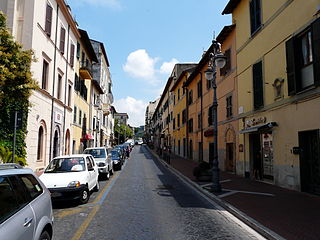
Grottaferrata is a comune (municipality) in the Metropolitan City of Rome Capital, situated on the lower slopes of the Alban Hills, 20 kilometres southeast of Rome. It has grown up around the Abbey of Santa Maria di Grottaferrata, founded in 1004. Nearby communes include Frascati, Rocca di Papa, Marino and Rome.

The Basilica of Saint Mary of the Altar in Heaven is a titular basilica and conventual church of the Franciscan Convent of Aracoeli located the highest summit of the Capitoline Hill in Rome, Italy. From 1250-1798 it was the headquarters of the General Curia of the Order of Friars Minor as well as being once of the cities principal civic churches. It is still the designated church of the city council of Rome, which uses the ancient title of Senatus Populusque Romanus. The present cardinal priest of the Titulus Sanctae Mariae de Aracoeli is Salvatore De Giorgi.

Antonio di Benedetto Aquilo degli Aquili, known as Antoniazzo Romano, was an Italian Early Renaissance painter, the leading figure of the Roman school during the latter part of the 15th century. He "made a speciality of repainting or interpreting older images, or generating new cult images with an archaic flavor", in particular by very often using the gold ground style, which was unusual by this period.

Marino is an Italian city and comune in Lazio, on the Alban Hills, Italy, 21 kilometres southeast of Rome, with a population of 37,684 and a territory of 26.10 square kilometres (10.08 sq mi). It is bounded by other communes, Castel Gandolfo, Albano Laziale, Rocca di Papa, Grottaferrata, and Ciampino. Marino is famous for its white wine, and for its Grape Festival, which has been celebrated since 1924.

The Roman Castles are a group of comuni in the Metropolitan City of Rome. They are located a short distance south-east of the city of Rome, at the feet of the Alban Hills, in the territory corresponding to the Old Latium.

Rocca di Papa is a small town and comune (municipality) in the Metropolitan City of Rome, Lazio, Italy. It is one of the Castelli Romani about 25 kilometres (16 mi) southeast of Rome on the Alban Hills. It is close to the other communes of Velletri, Rocca Priora, Monte Compatri, Grottaferrata, Albano and Marino. It is the center of the Regional Park known as the "Parco Regionale dei Castelli Romani".

The Castra Albana was an ancient Roman legionary fortress of the Legio II Parthica founded by the Emperor Septimius Severus (193–211) on the site of the present Albano Laziale.

The Villa of Domitian, known as Albanum Domitiani or Albanum Caesari in Latin, was a vast and sumptuous Roman villa or palace built by emperor Domitian. It was situated 20 km (12 mi) from Rome, high in the Alban Hills where summer temperatures are more comfortable. It faced west overlooking the sea and Ostia. To travellers on the via Appia it would have made an impressive sight.
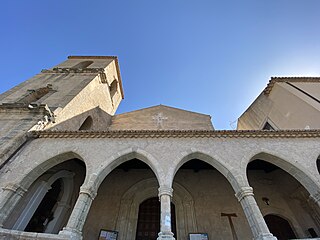
The Church of San Bernardino da Siena is a Catholic place of worship in the Italian municipality of Amantea, in the province of Cosenza in Calabria. It is situated 34 metres (112 ft) above sea level on the street of the same name in the Tyrrhenian town.
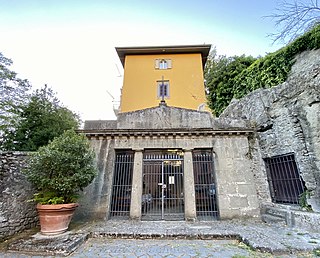
The sanctuary of Santa Maria dell'Acquasanta or Acqua Santa is a place of Catholic Marian worship in the city of Marino, in the Roman Castles area, in the metropolitan city of Rome Capital and suburbicarian diocese of Albano. It is currently included in the parish of the basilica of San Barnaba.

Palazzo Pamphilj is a historical palace in the city of Albano Laziale, in the province of Rome, in the Roman Castles area.

The sanctuary of Maria Santissima della Rotonda, formerly known as Santa Maria Maggiore, is an important Marian sanctuary in Lazio, located in the city of Albano Laziale, in the province of Rome, in the Roman Castles area.

Palazzo Colonna is a historic building in the center of Marino, in the Roman Castles area of the Metropolitan City of Rome, Italy. Currently, it houses the municipal headquarters of the municipality of Marino.

The collegiate basilica of St. Barnabas is the main place of Catholic worship in the city of Marino, in the metropolitan city of Rome Capital and suburbicarian diocese of Albano.
The history of the city of Marino, in the province of Rome, in the Roman Castles area, begins with the appearance of the first human settlements in the municipal territory during the Bronze Age. In the Middle Ages the castle knew its period of greatest splendor under the rule in turn of the Counts of Tusculum, the Frangipane, the Orsini, the Apostolic Chamber, the Caetani, and finally the Colonna, of whom it was a historic stronghold. Marinese events have often been of considerable importance in the local and sometimes even international historical context, so much so that various scholars in various eras have tried their hand at collecting the historical memories of this town. The castle was besieged several times, with mixed results, suffering at least four sackings and two destructions a fundamentis. However, the feudal lords and the community have been concerned at all times to erect monuments for public ornament, such as the only example of Gothic architecture in the Roman Castles, the former church of Santa Lucia, the sanctuary of Santa Maria dell'Acquasanta, the Frangipane and Orsini fortresses, Palazzo Colonna, the collegiate basilica of San Barnaba, Palazzo Matteotti, and many other public works. Numerous important personalities in politics, the arts, religion, and finance were also born, lived, or related in some way in Marino.
The historic centre of Albano Laziale corresponds to the territory of the first municipal decentralization district of the municipality of the same name of Albano Laziale, in the province of Rome, Lazio.

The Pontifical Villas of Castel Gandolfo are buildings erected in an area of about 55 hectares located in the Roman Castles, in the Metropolitan City of Rome Capital, included among the extraterritorial areas of the Holy See in Italy.


